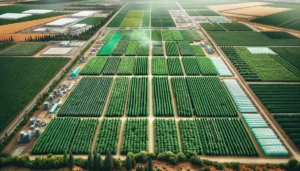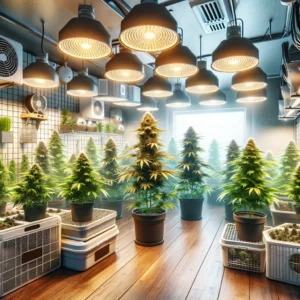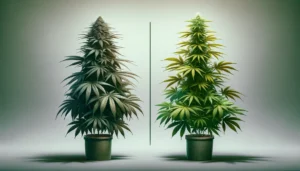Unveiling the Environmental Highs and Lows of Cannabis Cultivation
 Cannabis has long been in the shadow of controversy, both praised for its medicinal properties and shunned for its recreational use. But as the whirlwind of legalization sweeps across regions, the green industry is booming in more ways than one. Yet, with this growth comes a pressing question that’s more important than THC potency or terpene profiles: What are the environmental impacts of cannabis cultivation?
Cannabis has long been in the shadow of controversy, both praised for its medicinal properties and shunned for its recreational use. But as the whirlwind of legalization sweeps across regions, the green industry is booming in more ways than one. Yet, with this growth comes a pressing question that’s more important than THC potency or terpene profiles: What are the environmental impacts of cannabis cultivation?
Sustainability has become a buzzword, a kind of litmus test for the conscience of an industry. And as consumers, activists, and enthusiasts, we must take a sobering look at the environmental footprint of the cannabis cultivation industry. Join me as we explore the subtle nuances of an industry on the cusp of change and uncover the legacy cannabis farming is leaving on our planet.
A Budding Industry and Its Shadow
The rise of legal cannabis has been meteoric. With it has come innovation, investment, and more open conversations about the plant and its potential. Yet, behind the green rush, a less glamorous story unfolds. Cannabis cultivation, both outdoor and predominantly indoor, carries a weighty environmental toll that’s concerning for earth-conscious consumers.
Water Woes in Pot Paradise
Water, the elixir of life, is in disproportionally high demand in cannabis cultivation. A single plant can require gallons of water per day, leading to immense stresses on local water systems in dryer climates.
In desert states like California, the thirst of cannabis is often at odds with the needs of the community and local agriculture. With local water tables dropping and rivers dwindling, the cultivation of cannabis exacerbates an already dire situation.
The Power Behind the Pot
Energy consumption is another glaring issue, especially in the indoor grows that are becoming more prevalent. High-intensity lights, heating, and cooling systems all rack up staggering energy bills. To put it in perspective, the electricity demands of indoor cannabis cultivation can be six times higher than those of the average hospital.
We take a critical look at how these energy demands are met and explore the strides being made (or not made) in integrating renewable energy sources into cannabis cultivation.
Pests, Pesticides, and the Circle of Life
No conversation about farming is complete without addressing pest management. The cannabis industry is sometimes over-reliant on pesticides and chemical fertilizers, which can lead to a cascade of negative environmental costs of cultivating cannabis.
We’ll dissect the types of chemicals commonly used, their pathways into ecosystems, and the ripple effects on local wildlife and water quality. The conundrum of pest management in a world slowly phasing out synthetic chemicals is a complex one that the cannabis industry is only beginning to grapple with.
The Earth in the Balance – Land and Carbon
Land Grabs and Deforestation
Cannabis cultivation can lead to significant land use changes. Illicit grows often contribute to deforestation, while large-scale legal operations can displace other forms of agriculture or encroach on natural habitats. Just how many acres of trees are falling to make way for cannabis farms? And what does this mean for local ecosystems?
Trapped in Plastic – Waste Woes
Cannabis is often presented as a holistic alternative, yet the reality is often entangled in plastic. The packaging of cannabis products can be excessive and the waste produced by cultivation, from leftover plant material to single-use equipment, is significant.
We investigate the waste that goes hand in hand with the weed and explore potential solutions in the growing movement for sustainability in the cannabis sector, from biodegradable packaging to creative repurposing of plant waste.
The Invisible Cloud – Carbon Emissions
Carbon footprints don’t discriminate. Whether the cannabis is grown under the sun or under high-powered lamps, emissions are an inescapable byproduct. We take an exhaustive look at the carbon trail left by cannabis, with a nod to the pioneers working to make greener practices the norm.
As part of environmental impacts of cannabis cultivation, we’ll discuss carbon offsets, the feasibility of carbon-neutral cannabis, and the impact of greenwashing in an industry navigating environmental accountability.
Protecting Paradise – Wildlife and Ecosystems
The Good, the Bad, and the Ugly
Cannabis farms can both harm and help local wildlife and ecosystems. Some farms serve as havens for biodiversity, while others contribute to habitat destruction and pollution.
I present cases of cannabis cultivation acting as a steward of the environment as well as cautionary tales of how the industry can disrupt the delicate dance of local ecology.
Crafting a Path to Green Cultivation
Seeds of Change – Sustainable Practices
Sustainable cannabis farming is not an oxymoron. We explore the methods and technologies that can lessen the industry’s environmental impacts of cannabis cultivation, from water-wise cultivation techniques to organic pest control.
Navigating the Regulatory Landscape
Laws and regulations play a pivotal role in shaping the environmental practices of the cannabis industry. I shed light on existing regulations and discuss ways the legal framework can evolve to promote sustainable cultivation.
The Road Ahead
We close with a forward-looking perspective on the future of cannabis cultivation. What can policymakers, consumers, and industry insiders do to ensure a greener, more sustainable future for pot farming?
It’s clear that for the cannabis industry to truly come into its own, it must grapple with its environmental legacy. With every puff of a joint and pot brownie consumed, consumers cast a vote for the kind of cannabis industry they want to support. It’s time for us all to take a hit of responsibility and collectively work towards a more sustainable, eco-friendly approach to cannabis cultivation. Our planet may just depend on it.



